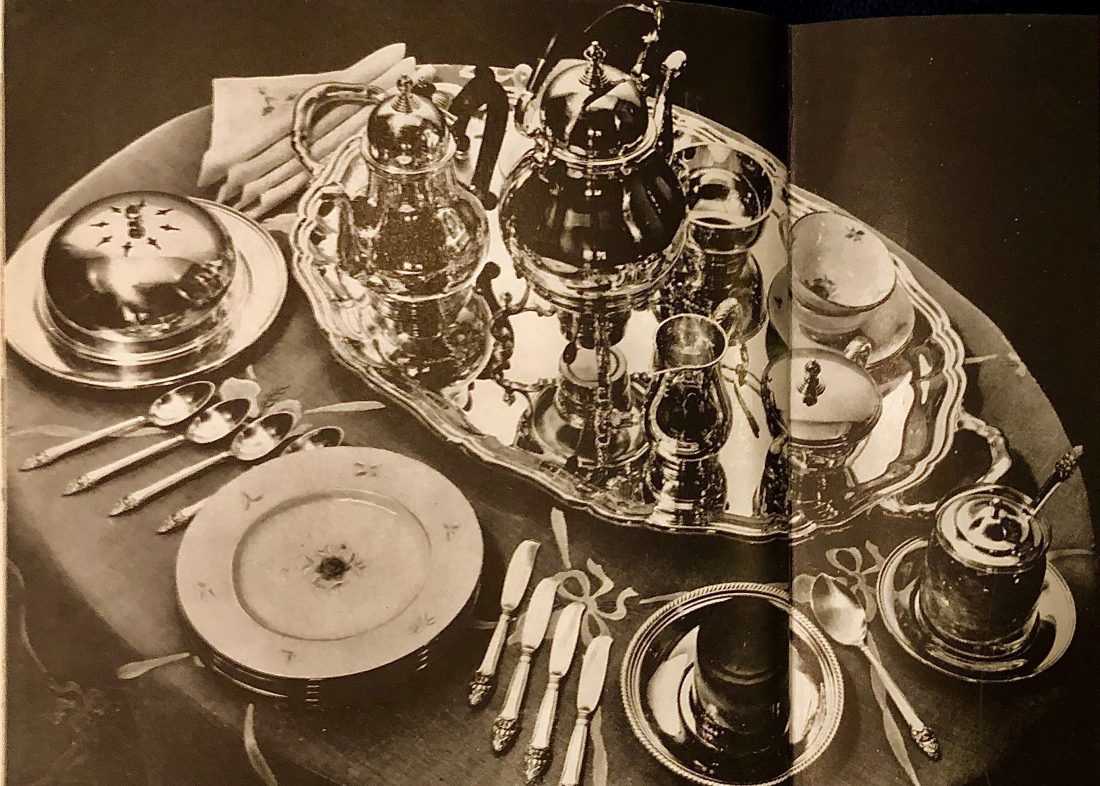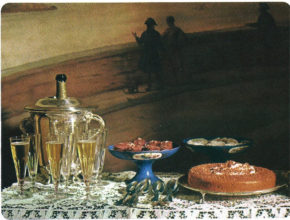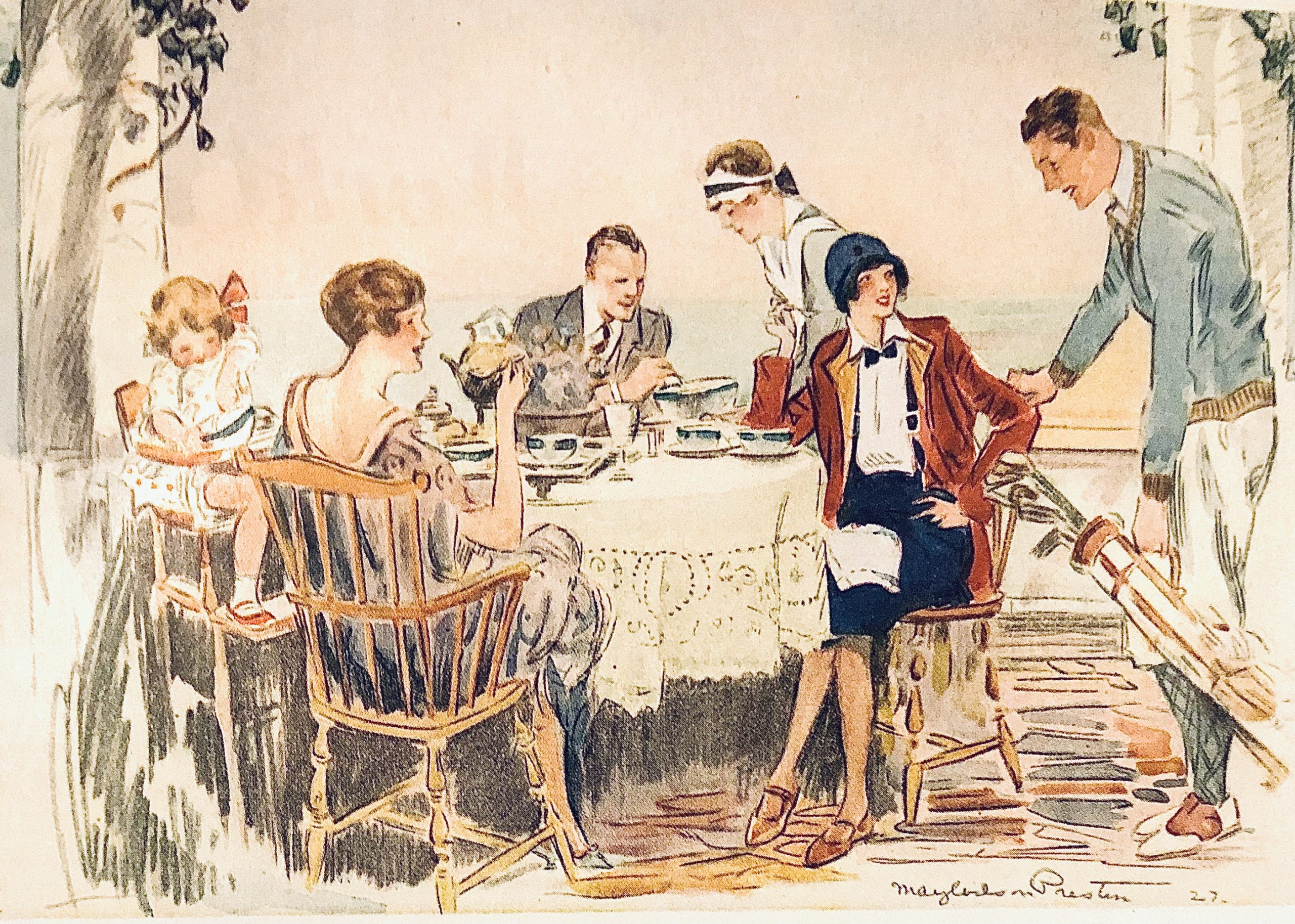“In setting up any service for afternoon tea, the convenience in pouring must be the first consideration,. The teapot must be at the right of the one serving, and the fruit, sugar, and cream in front where they can be easily reached, The cups and saucers should be at the left in piles of two cups and saucers. Always place the cups on the saucers; they are never placed on the table by themselves.”
Table Service and Decoration, Lilian M. Gunn (1928)
When you look at modern books on afternoon tea, the recipes tend to be fussy and complicated because tea has turned into a special occasion, not a common occurrence. We’re going to skip all of that fuss. As we discussed earlier, tea was never meant to be overly complicated. What we’re talking about here, is the type of tea you would have had in a lady’s home prior to the 1980s. It will be traditional and delicious. What it will not be, is pretentious or complex.

Traditional Afternoon Tea consists of the savory, the sweet and the liquid. The savory is traditionally, tiny little sandwiches made of very simple and very fresh ingredients. The sweet is usually scones with clotted cream, a jam and often butter and possibly cake fingers. For a home get together, two types of sandwiches and two types of sweet will do. If you’re having more than a couple close friends, make three sandwiches.
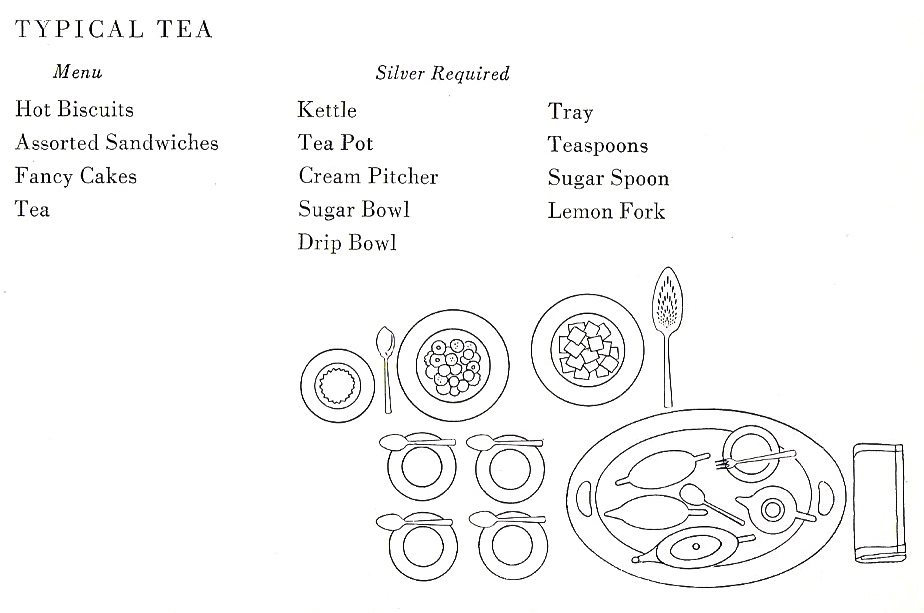
Prior to the 1980’s, Americans, as you can see above, considered a normal tea as Biscuits, Sandwiches and Cakes. Scones really made a move into American consciousness during the Victorian revival after A Room With A View came out and all things British and Victorian became fashionable. I personally love a good American cream biscuit for tea. Sandwiches were also more American at that time, so feel free to deviate according to local tastes.
This is not fancy tea, this is “come over for a chat” tea. For those who are just starting out entertaining, here is the easiest place to begin.
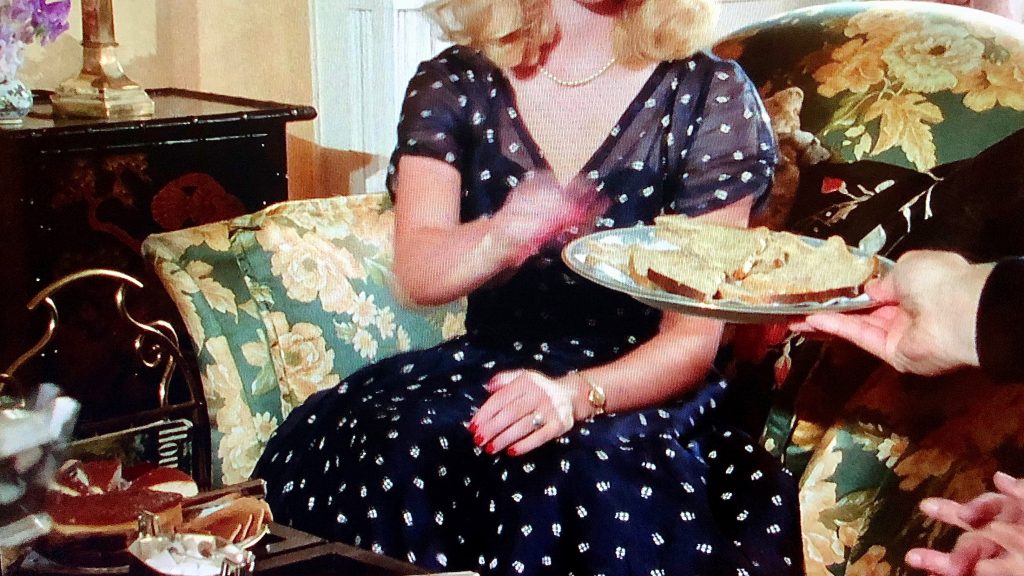
Bread and Butter Sandwiches
“ALGERNON – Please don’t touch the cucumber sandwiches. They are ordered specially for Aunt Augusta. [Takes one and eats it.]
JACK – Well, you have been eating them all the time.
ALGERNON – That is quite a different matter. She is my aunt. [Takes plate from below.] Have some bread and butter. The bread and butter is for Gwendolen. Gwendolen is devoted to bread and butter. “
The Importance of Being Earnest by Oscar Wilde
Oscar Wilde knew of what he wrote. Bread and butter sandwiches dominated tea well into the 1970’s. Yes, seriously, bread and butter sandwiches. This is firm white bread pressed flat, slathered with high quality butter and rolled into tight spirals or left open faced. That’s it.
Before you turn up your nose in distain, know that this is a traditional tea sandwich and is perfectly correct. And before you say that our modern palates have become too refined for something so basic, I call bullshit. White bread is the nutritional equivalent of carbohydrate candy. Most of us eat whole wheat for our health, and well we should. In my house we usually eat Ezekial bread with is basically edible sandpaper. It is very nutritious and good for you, but it isn’t the glory that is old-fashioned American white bread. When you offer someone a plate of bread and butter sandwiches you are offering them a taste of heaven.
To Make:
What you’ll need is fresh, firm, white bread and high-quality sweet cream butter that has been allowed to reach room temperature. I’m particularly fond of New Zealand or Irish salted sweet cream butter for this. You will also need tea knife, a rolling pin and toothpicks.
Quick note on the ingredients: If you can, buy the bread fresh from a really good bakery or bake your own if you’re good at that sort of thing. As for the butter, buy it as close to the tea as possible, butter takes on flavors from your fridge quicker than anything else. Where there will be no flavor but bread and butter, both should taste amazing. Keep the butter in a ziplock bag until you use it.
Now, cut the crusts off the bread, (I save a bag of the crusts in the freezer for bread pudding) and cut in half to form rectangles. Roll over the slices with the rolling pin until they are flattened. Spread the butter on the bread. Don’t skimp. Roll the bread from the thin end into tight spirals. Put a toothpick through each sandwich to keep its shape. Put on a plate or on a cookie sheet and cover with a damp tea towel, (not wet – just sprinkled with water) and cover with saran wrap or place in a large zip lock bag. Chill overnight. When you’re ready to serve, remove the toothpicks bring to room temperature.
Make 3-4 per person.
Cucumber Sandwiches
1 loaf fresh white bread, sliced and crust cut off
½ pound soft salted sweet cream butter
Cucumber, peeled and sliced so thin as to be seen through
Now I never eat these as I’m allergic to everything in the melon family, but they are a classic tea sandwich. It’s white bread, lightly pressed, with the crusts cut off and cut into either rectangles or triangles, then spread with butter and very, very thin slices of peeled cucumber laid on.
My mother’s trick to make the cucumber taste really good: Peel and slice very thin, place on a cookie sheet lined with a cooling rack, sprinkle with vinegar and salt. After a half hour drain the moisture off and wipe off any residual salt. If you do this, use unsalted butter. Assemble as before.
Some people leave these open faced and some make a closed sandwich. Up to you.
Rolled Watercress Sandwiches
1 loaf fresh white bread, sliced and crust cut off
½ pound soft salted sweet cream butter
1 cup chopped watercress, washed and dried
Place slices on dampened towels. Roll flat with a rolling pin. Spread with butter and cover with watercress. Roll up and cut each roll in half. Place a thin toothpick in each. Put on a plate or a cookie sheet and cover with a damp tea towel and cover with saran wrap or place in a large zip lock bag. You can also get unsliced bread and make long thin slices, roll them thickly and slice into spirals.
Because of the similarity in ingredients, I’d serve one of these three. Some like watercress on rye bread. I’d advocate for this if the other sandwiches you serve use white bread.
Smoked Salmon Sandwiches
Smoked Salmon, sliced thin
8 ounces of cream cheese, room temp, blended with a squeeze of lemon until spreadable
1 bunch of fresh dill, chopped fine
Freshly ground white pepper
Use thin sliced, hard, dense, white bread. Coat bread with cream cheese. Lay salmon on the bread and sprinkle chopped fresh dill on top. Add a dash of white pepper. Top with bread and slice into rectangles or triangles.
Alternate sandwich is to add chopped capers instead of dill, if you do this then skip the lemon juice.
Or
Fish Paste Sandwiches
Sounds appetizing, no? Popular for years in Britain, still popular all over Scandinavia, I came to these late. I used to get the fish paste from Ikea, but they stopped selling it. Now I order tubes from a Swedish food supplier. My favorite sandwich is equal parts smoked salmon paste and cream cheese blended together with a squeeze of lemon, spread on a good firm thinly sliced wheat bread with a thin slice of tomato on top, (chopped capers are good too). Depending on the kind of fish paste you buy, this can be very salty – just up the amount of cream cheese a wee bit.
Egg Salad Sandwiches
5 eggs, had boiled, shelled and chopped
Mayonnaise
Tabasco or Siracha Sauce
1 teaspoon Dijon mustard
A dark heavy bread, sliced and rolled lightly
Salted sweet cream butter
Mix together egg, enough mayonnaise to wet the eggs, dash of hot sauce to taste and Dijon mustard. Spread onto bread and top with another slice of bread that has been buttered.
Hippie Snacks
Non-Traditional as they are something my mother made me as an after school snack. I then tweaked the recipe and began serving these with tea. People love them.
Blend ¼ cup butter with ¼ cup cream cheese. Drizzle in 2 tablespoons honey, (more or less depending on your own tastes). Stir in 1/4 cup chopped and toasted walnuts. Spread this on thinly sliced squaw bread, (the dark Cheesecake factory bread available in grocery stores in a good facimile). Peel, core and slice a sweet/tart apple into very thin slices. Toss in Lemon juice. Lay slices of apple on each sandwich in a single layer.
In the fall I like to add a little cinnamon to the butter and cream cheese mix. If you have a nut allergy, just leave them out.
Dried Fruit Scones
Ok, these are a little more complicated. They just happen to be my favorite recipe for scones. They came from my grandmother, on one of her little recipe cards that probably came from the 1920’s or 1930’s.
3 cups flour
¼ cup sugar
1 tablespoon baking powder
1/3 cup butter, cut in pieces
1 cup dried cherries or cranberries (chopped dried apricots, peaches, white raisins also work), well chopped
2 tablespoons orange zest
¼ teaspoon cardamom
¾ cup heavy cream
2 large eggs
Preheat your oven to 350 degrees.
In a large bowl combine the flour, sugar, and baking powder. Using a pastry cutter, cut in butter until mix is crumbly, (you don’t have to have a pastry cutter, a fork will do just fine).
Stir in fruit, orange zest and cardamom. In a small bowl combine cream and eggs and add to dry ingredients, stirring only just until moist.
On a lightly floured surface, roll or pat dough to 1-inch thickness. Using 2-inch cutter, cut scones and place on baking sheet.
Bake 16-18 minutes or until they are golden brown.
Here are a couple tea sandwiches from the Victorian Period as found in the Fannie Farmer Cooking School Magazine.
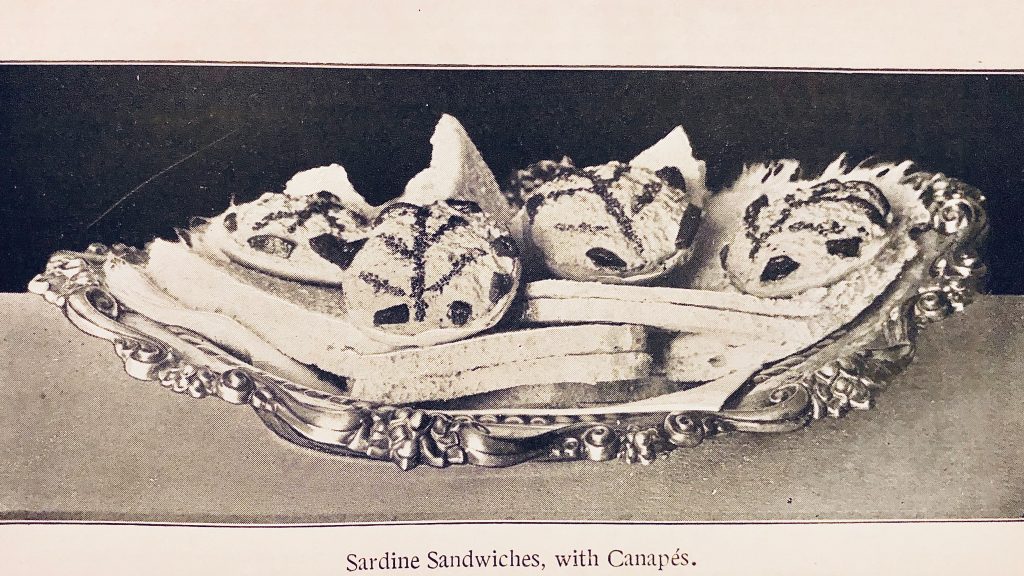
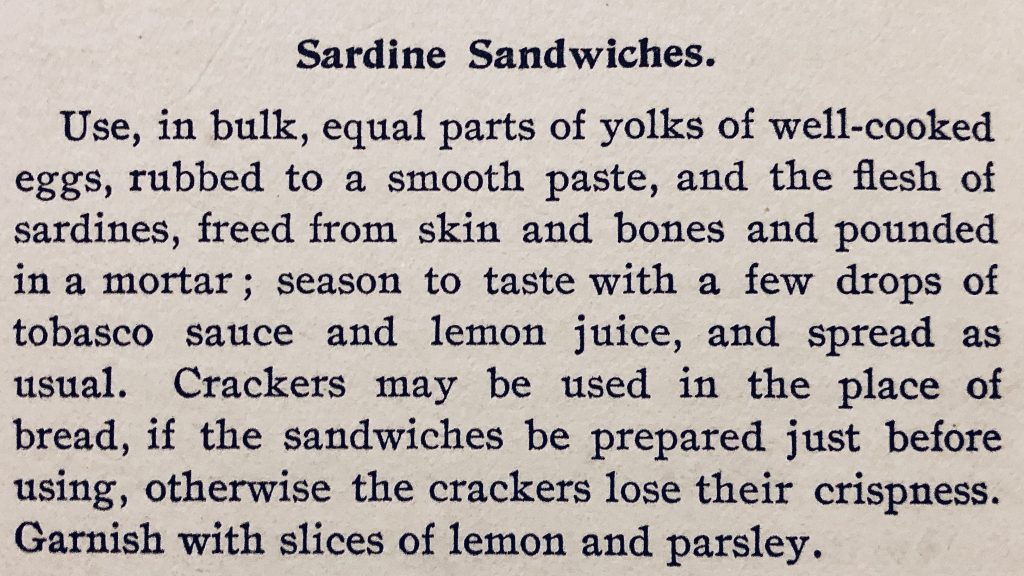
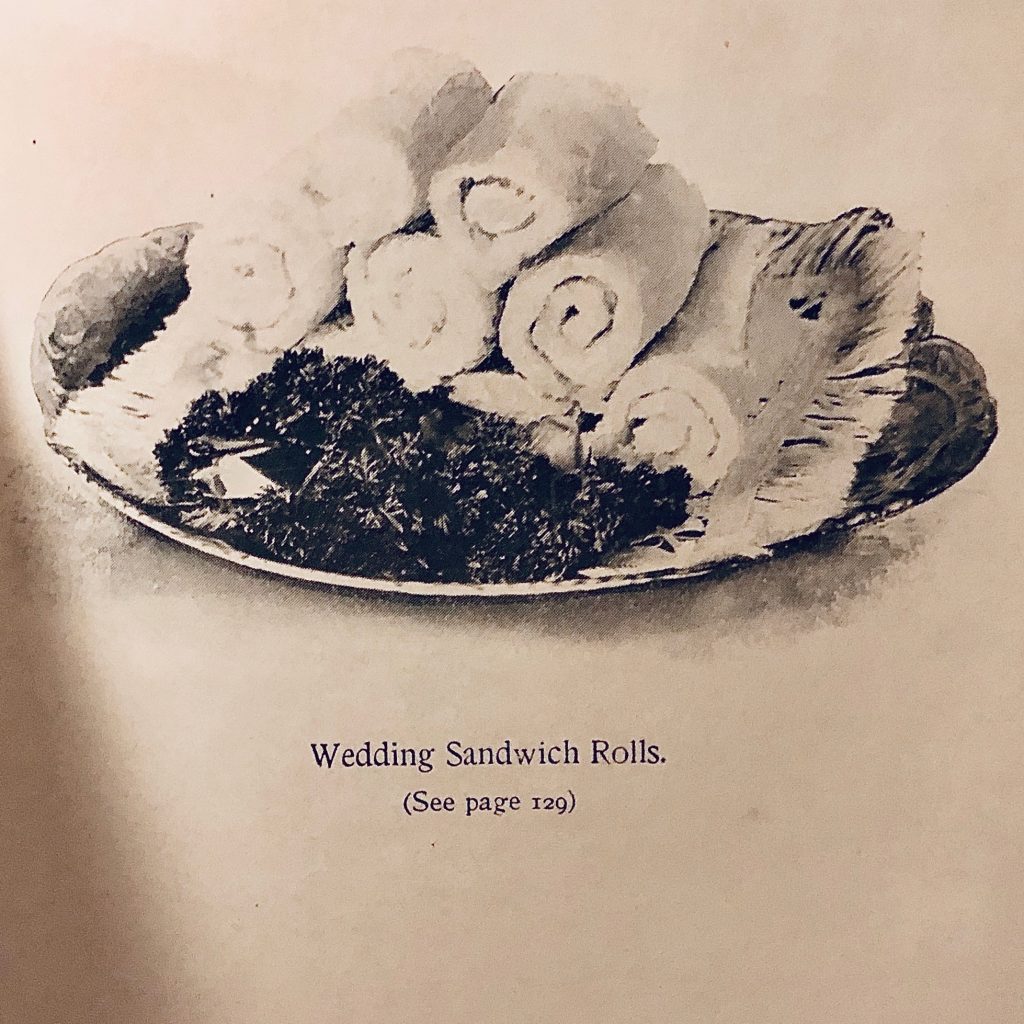
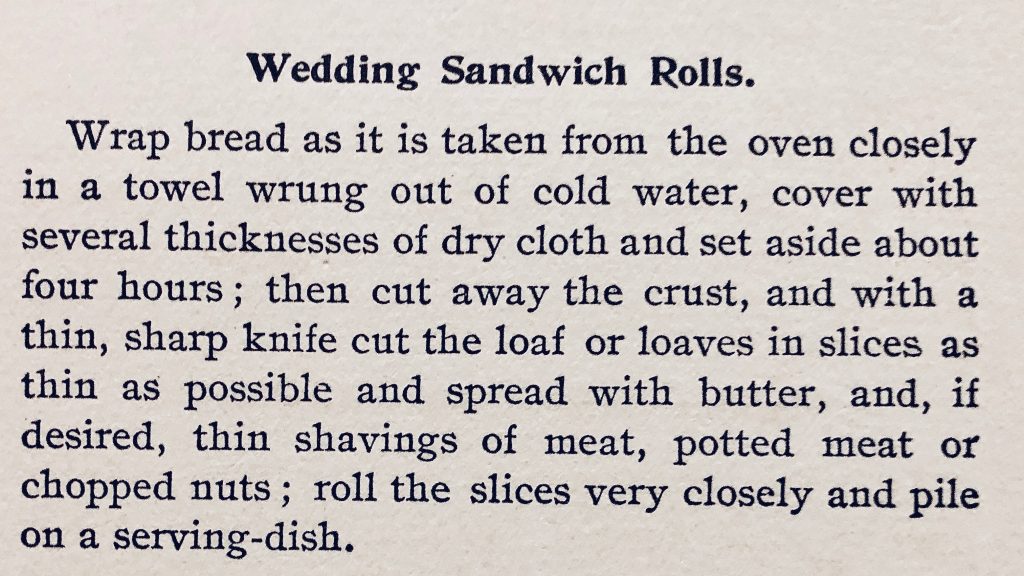
I hope you try some of these and invite a friend over. They are so simple and easy, as tea should be. Let me know how you get on.
